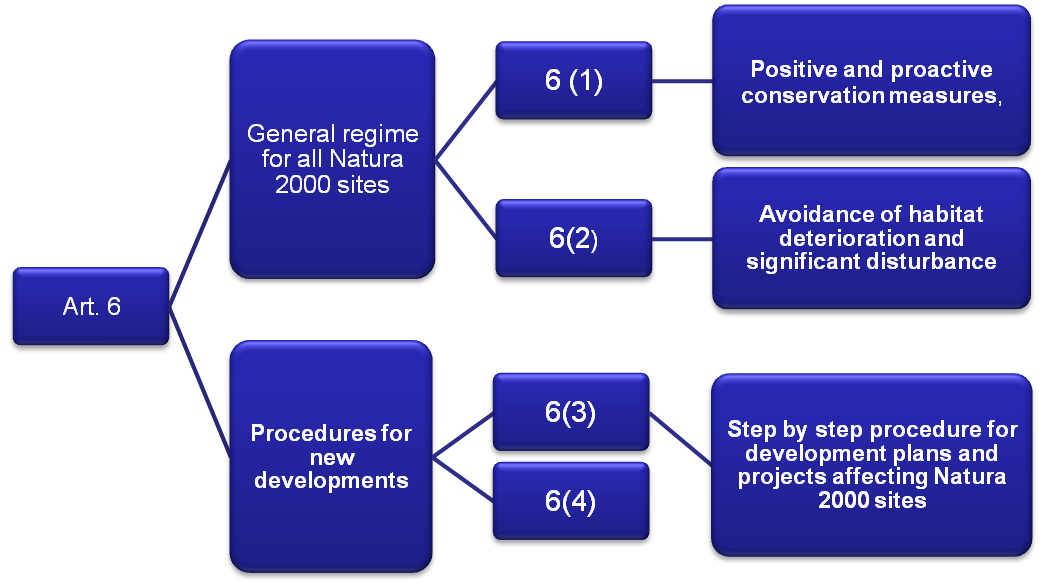Site Protection Measures under the Article 6 of the Habitats Directive
Article 6 is a key provision of the Habitats Directive, as it sets out the framework for site conservation and protection, and includes proactive, preventive and procedural requirements. It imposes upon the Member States a series of specific obligations and procedures designed, as is clear from Article 2(2) of the directive, to maintain, or as the case may be restore, at a favourable conservation status natural habitats and species of wild fauna and flora of interest for the European Union, in order to attain the directive’s more general objective, which is to ensure a high level of environmental protection as regards the sites protected pursuant to it.  In that context, the Habitats Directive has the aim that the Member States take appropriate protective measures to preserve the ecological characteristics of sites which host natural habitat types.
In that context, the Habitats Directive has the aim that the Member States take appropriate protective measures to preserve the ecological characteristics of sites which host natural habitat types. 
Article 6(2), (3) and (4) applies to SCIs (according to Article 4(5) of the Habitats Directive). Article 6(1) applies only to SACs, which are also subject to the requirements of Article 6(2), (3) and (4). Given that Article 6 sets out provisions which govern the conservation and management of Natura 2000 sites, this is the regulation which most determines the relationship between conservation and land use.
Briefly, the Article has three main sets of provisions: Article 6(1) makes provision for the establishment of the necessary conservation measures, and is focused on positive and proactive interventions; Article 6(2) makes provision for avoidance of habitat deterioration and significant species disturbance. Its emphasis is therefore preventive; Article 6(3) and (4) set out a series of procedural and substantive safeguards governing plans and projects likely to have a significant effect on a Natura 2000 site. Within this structure, it can be seen in the schema below that there is a distinction between Article 6(1) and (2) which define a general regime and Article 6(3) and (4) which define a procedure applying to specific circumstances.
The general regime in Article 6(2) is nevertheless rather strict which means that an activity complies with this regime only if it is guaranteed that it will not cause any disturbance likely significantly to affect the objectives of that directive, particularly its conservation objectives.  As a consequence, in order to establish failure to fulfil obligations under Article 6(2) of the Habitats Directive, the existence of a cause-and-effect relationship between the activities (for example, constructions) and significant disturbance caused to the species concerned does not need to be established. It is sufficient to establish that there is a probability or risk that that the activity will cause significant disturbance to those species.
As a consequence, in order to establish failure to fulfil obligations under Article 6(2) of the Habitats Directive, the existence of a cause-and-effect relationship between the activities (for example, constructions) and significant disturbance caused to the species concerned does not need to be established. It is sufficient to establish that there is a probability or risk that that the activity will cause significant disturbance to those species. 
It should be noted that Article 6(2), like the first sentence of Article 4(4) of the Birds Directive, requires Member States to take appropriate steps to avoid, in SPAs classified in accordance with Article 4(1) of the Birds Directive, deterioration of habitats and disturbance significantly affecting the species for which the SPAs have been classified.  As regards areas classified as SPAs, Article 7 of the Habitats Directive provides that the obligations arising under Article 4(4) of the Birds Directive are replaced, inter alia, by the obligations arising under Article 6(2) of the Habitats Directive as from the date of implementation of the Habitats Directive or the date of classification under the Birds Directive, where the latter date is later.
As regards areas classified as SPAs, Article 7 of the Habitats Directive provides that the obligations arising under Article 4(4) of the Birds Directive are replaced, inter alia, by the obligations arising under Article 6(2) of the Habitats Directive as from the date of implementation of the Habitats Directive or the date of classification under the Birds Directive, where the latter date is later. 

Article 6 of the Habitats Directive
Source: Source: Joseph van der Stegen, DG Environment, European Commission
Considered globally, the provisions of Article 6 reflect the general orientation expressed in the recitals of the Directive. This involves the need to promote biodiversity by maintaining or restoring certain habitats and species at ‘favourable conservation status’ within the context of Natura 2000 sites, while taking into account economic, social, cultural and regional requirements, as a means to achieving sustainable development.